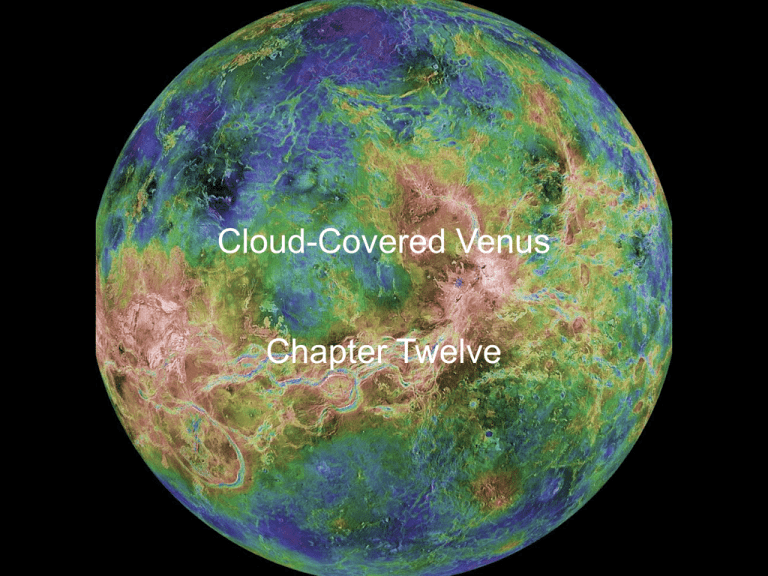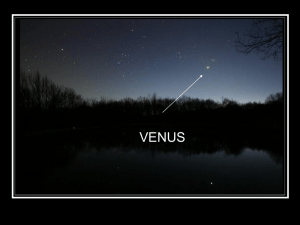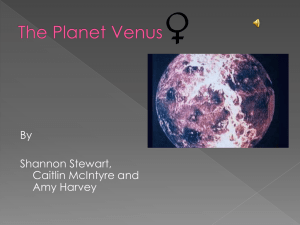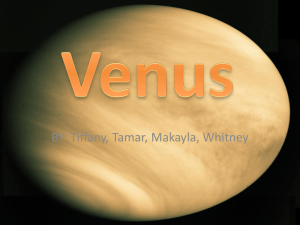Powerpoint Presentation (large file)
advertisement

Cloud-Covered Venus Chapter Twelve Guiding Questions 1. What makes Venus such a brilliant “morning star” or “evening star”? 2. What is strange about the rotation of Venus? 3. In what ways does Venus’s atmosphere differ radically from our own? 4. Why do astronomers suspect that there are active volcanoes on Venus? 5. Why is there almost no water on Venus today? Why do astronomers think that water was once very common on Venus? 6. Does Venus have the same kind of active surface geology as the Earth? • At its greatest eastern and western elongations, Venus is about 47° from the Sun • It can be seen for several hours after sunset or before sunrise The surface of Venus is hidden beneath a thick, highly reflective cloud cover • Venus is similar to the Earth in its size, mass, average density, and surface gravity • It is covered by unbroken, highly reflective clouds that conceal its other features from Earthbased observers In 1962 the unmanned U.S. spacecraft Mariner 2 made the first close flyby of Venus Venus’s rotation is slow and retrograde • Venus rotates slowly in a retrograde direction with a solar day of 117 Earth days and a rotation period of 243 Earth days • There are approximately two Venusian solar days in a Venusian year. Venus has a hot, dense atmosphere and corrosive cloud layers • Spacecraft measurements reveal that 96.5% of the Venusian atmosphere is carbon dioxide • Most of the balance of the atmosphere is nitrogen. • Venus’s clouds consist of droplets of concentrated sulfuric acid. • The surface pressure on Venus is 90 atm, and the surface temperature is 460°C • Both temperature and pressure decrease as altitude increases The upper cloud layers of the Venusian atmosphere move rapidly around the planet in a retrograde direction, with a period of only about 4 Earth days The circulation of the Venusian atmosphere is dominated by two huge convection currents in the cloud layers, one in the northern hemisphere and one in the southern hemisphere Volcanic eruptions are probably responsible for Venus’s clouds • Venus’s clouds consist of droplets of concentrated sulfuric acid • Active volcanoes on Venus may be a continual source of this sulfurous material The density of craters suggests that the entire surface of Venus is no more than a few hundred million years old. According to the equilibrium resurfacing hypothesis, this happens because old craters are erased by ongoing volcanic eruptions The climate on Venus followed a different evolutionary path from that on Earth • Venus’s high temperature is caused by the greenhouse effect, as the dense carbon dioxide atmosphere traps and retains energy from sunlight. • The early atmosphere of Venus contained substantial amounts of water vapor • This caused a runaway greenhouse effect that evaporated Venus’s oceans and drove carbon dioxide out of the rocks and into the atmosphere • Almost all of the water vapor was eventually lost by the action of ultraviolet radiation on the upper atmosphere. • The Earth has roughly as much carbon dioxide as Venus, but it has been dissolved in the Earth’s oceans and chemically bound into its rocks The surface of Venus shows no evidence of plate tectonics • The surface of Venus is surprisingly flat, mostly covered with gently rolling hills • There are a few major highlands and several large volcanoes • The surface of Venus shows no evidence of the motion of large crustal plates, which plays a major role in shaping the Earth’s surface Venusian Surfaces Key Words • • • • • • • equilibrium resurfacing hypothesis global catastrophe hypothesis hot-spot volcanism prograde rotation retrograde rotation runaway greenhouse effect shield volcano







